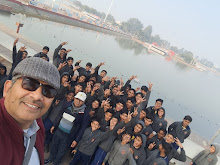44th JAWAHARLAL NEHRU NATIONAL SCIENCE, MATHEMATICS
AND ENVIRONMENT EXHIBITION FOR CHILDREN — 2017
STATE LEVEL SCIENCE, MATHEMATICS AND ENVIRONMENT
EXHIBITION FOR CHILDREN — 2016-17
Theme for the State Level Science, Mathematics and Environment Exhibition (SLSMEE) for Children – 2016-17 has been chosen as Science, Technology and Mathematics for Nation Building.
- The Green India,
- Make in India,
- Smart City,
- Beti Bachao Beti Padhao,
- Pradhan Mantri Jan Dhan Yojana,
- Saansad Adarsh Gram Yojana,
- Digital India,
- Swachh Bharat
are some of the recent initiatives taken by the government of India to build a better future for the country.
The theme and sub-themes identifi ed for SLSMEE-2016-17 are directly or indirectly focusing on the above mentioned initiatives of the government.
However, there are instances when children and their teachers think of some ideas that are new and may be applicable in future. Often such ideas may not be possible to be presented in the form of model/exhibit. Organizers of exhibitions at all levels may provide opportunities to students and teachers to present such ideas in the form of presentations and discussions.
The theme for SLSMEE-2016-17 and JNNSMEE-2017, “Science, Technology and Mathematics for Nation Building” aims to cover subthemes such as-
1. Health;
2. Industry;
3. Transport and Communication;
4. Innovations in renewable resources for sustainable environment;
5. Innovations in food production and food security;
6. Mathematical solutions in everyday life
The exempler points listed so far are to trigger ideas and give directions for preparing exhibits and are not exhaustive. Further we would once again reiterate that, students and teachers are free to choose any subtheme, even a sub-theme not listed in this guidelines.
However the chosen sub-theme and the exhibits/models developed should be in the context of the theme: Science, Technology and Mathematics for Nation Building. Examples of write-ups of exhibits from the previous JNNSMEE are also given at the end of this booklet for facilitating the preparation of exhibits and models for students and teachers.
1. Involvement of children’s own creativity and imagination (20 percent);
2. Originality and scientific and mathematical innovations in the exhibit/model (15 percent);
3. Scientifi c thought/ principle/ approach (15 percent);
4. Technical skill, workmanship and craftsmanship (15 percent);
5. Utility for Society, scalability (15 percent);
6. Economic (low cost), portability, durability, etc. (10 percent); and
7. Presentation - aspects like demonstration, explanation and display (10 percent).
(i) 5% extra weightage may be given to exhibits from rural/backward regions.
(ii) 3% extra weightage may be given to exhibits from semi urban regions.
In addition to this, two best exhibits developed by disabled students from any of the sub-themes may also be forwarded to NCERT. It must be kept in mind that entries submitted under this category should be displayed only by the disabled students. Further the entries forwarded should be accompanied with disability certifi cate from a competent authority. Disability norms followed by the government of India will be considered under this category.
CRITERIA FOR EVALUATION OF EXHIBITS IN SLSMEE
In order to keep a uniform criteria for evaluating the exhibits in all States/ UTs and on the basis of the feedback received from different agencies, the following criteria for judging the exhibits is suggested.
(the percentages given in bracket are suggestive weightages):.
1. Originality and innovations in the
exhibit/model (25 percent);
2. Scientific thought/ principle/
approach (20 percent);
3. Utility for Society, Scalability ; (20
percent)
4. Economic (low cost), portability,
durability, etc. (15 percent); and
5. Presentation of write-up: (20 percent)
http://www.ncert.nic.in/programmes/science_exibition/EnglishGuidelines2016_17.pdf


No comments:
Post a Comment